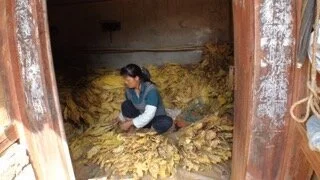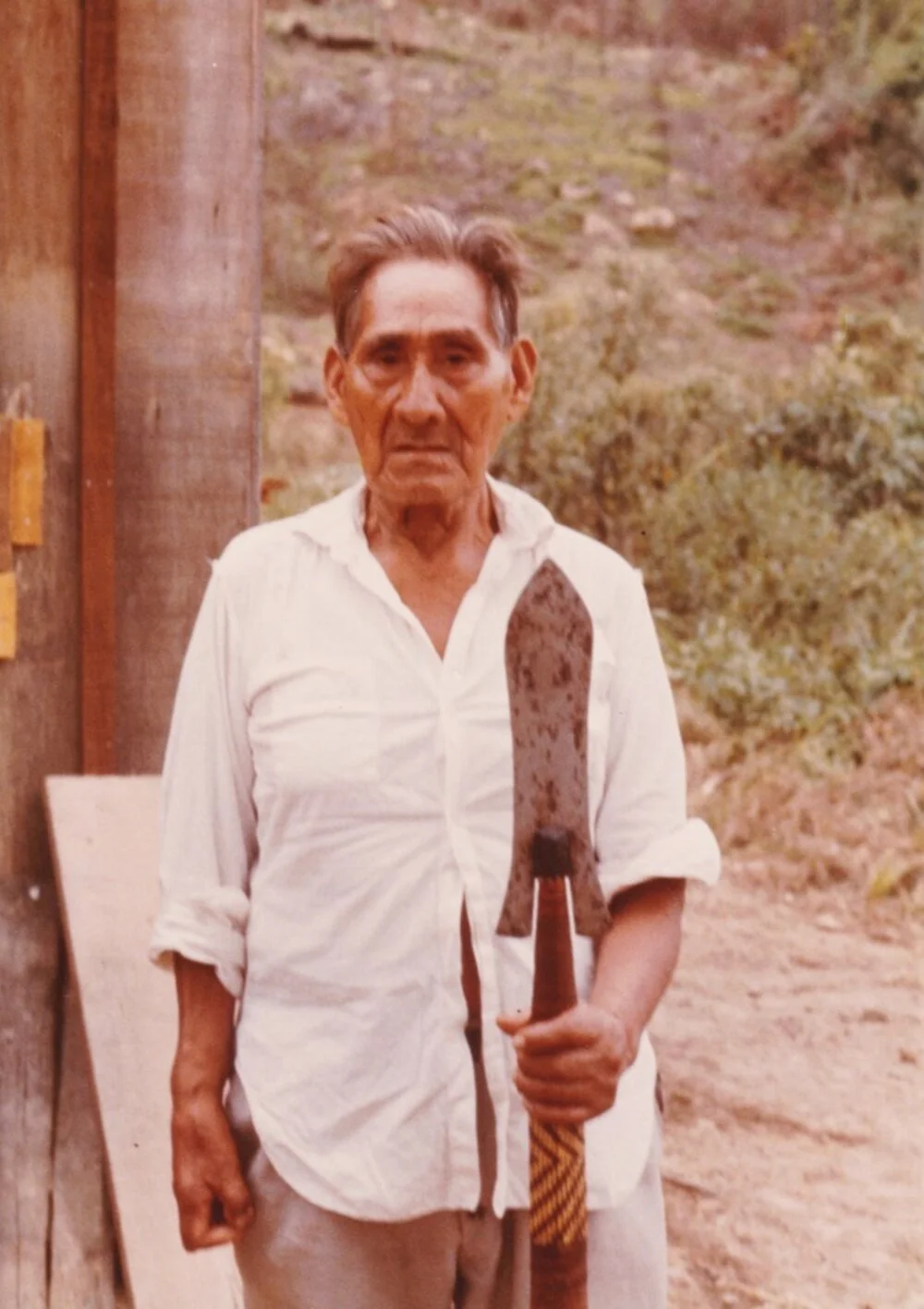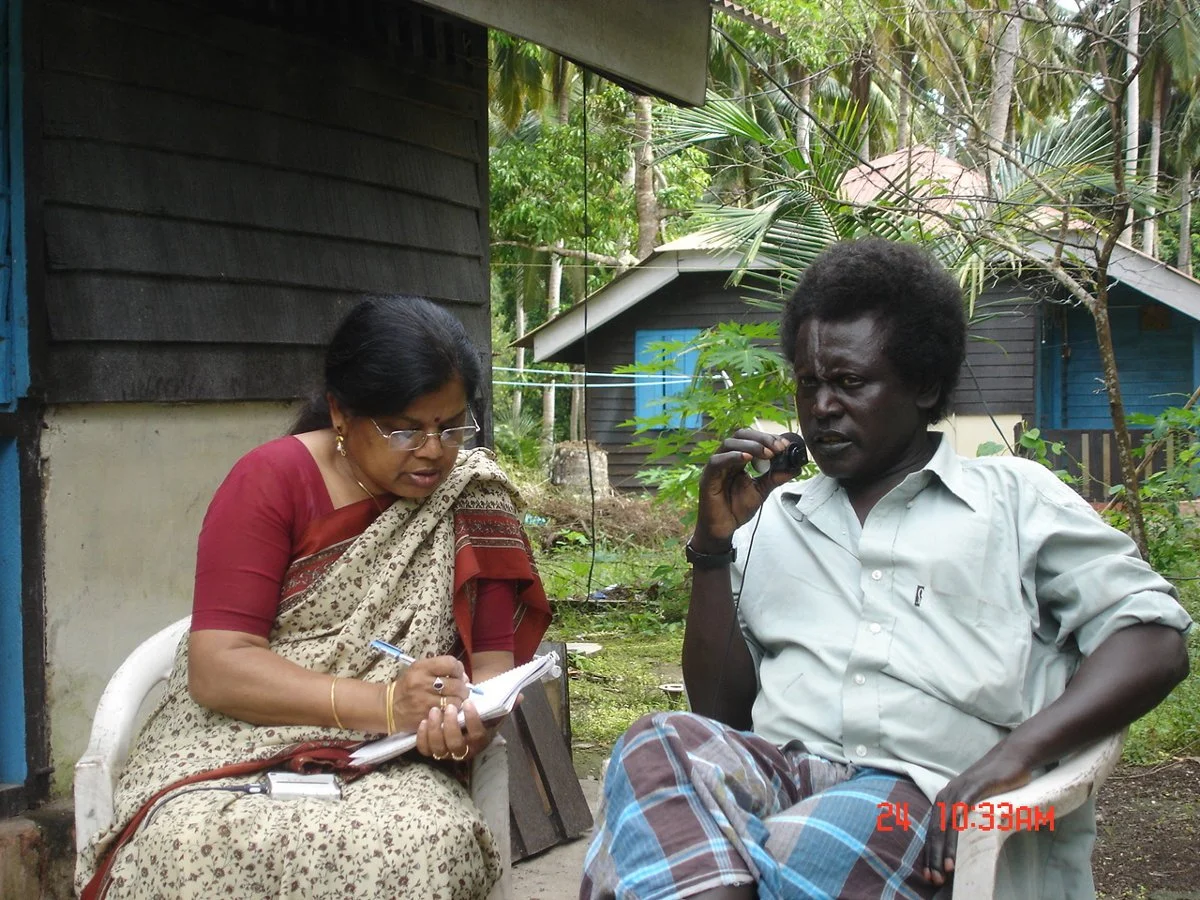STORIES
Great Andamanese
My Life with the great andamanese
September 26, 2016
by Dr. Anvita Abbi
Honorary Director of Centre for Oral and Tribal Literature
Sahitya Akademi, New Delhi, India
Adjunct Professor, Simon Fraser University, Vancouver, Canada
President: Linguistic Society of India
www.andamanese.net
Great Andamanese community with Anvita Abbi & Abhishek Avtans
The fieldwork in the Andaman was not easy. The first trip that we made to the Andaman Islands was in December 2001, under the project ‘Linguistic Survey of the Tribal and Contact Languages of the Andaman Islands’ (2001–2002) to conduct a pilot survey of the languages spoken in Great Andaman and Little Andaman.The project was supported by the Max Planck Institute of Evolutionary Anthropology, Leipzig. I was introduced to the Andaman Islands for the first time during this project. I was assisted by two of my students. On our way to Little Andaman, where Onge live, we experienced the jungles of Little Andaman, saw water snakes more poisonous than any cobra, crossed narrow creeks laden with crocodiles, and lived in shanties regularly visited by snakes, scorpions and leeches. In our ignorance, we had armed ourselves only against mosquitoes by taking along coils and mosquito repellent tablets. Who knew that the simple act of dipping one’s feet in the water to cool oneself would invite water snakes? Apparently, sea water under the jetty at the Dugong Creek was full of poisonous water snakes. Thanks to the local who saved my life by pushing me off the jetty at the right time!
Our life on Strait Island
As part of the project on Vanishing Voices of the Great Andamanese (2005-2009), we were to spend some time on Strait Island, an island which is 53 nautical miles from the city of Port Blair and to which public visits are banned. To reach the island one has to take a ship, which sails only twice a week. The ship does not have Strait Island as its ultimate destination, but only stops over there briefly en route to two North Andaman Islands ports viz. Mayabandar and Diglipur. It was in January 2006 that I went to Strait Island along with two research assistants, Narayan and Abhishek, for the second time in the five weeks that we spent in the Andaman Islands. The AAJVS (Andaman Adim Janjati Vikas Samiti viz. The Tribal Welfare Society) had arranged for accommodation for us in a government guest-house. The situation of this guest house was deplorable. There were two bare-walled
An Ancient Tale From Andaman
rooms, each with a dirty but functional attached bathroom, windows without screens, and a hard, wooden bed to sleep on. The only other furniture in the room was three plastic chairs for each of us. Birds, bats and insects could freely wander into our rooms at night since we could not imagine closing the windows, given the sultry, humid weather and the absence of fans. The good old Indian mosquito net was the only shield we had against these intruders. The only luxuries here were the cotton sheets that we were given to cover ourselves and two-hour electric supply generated by solar power, which we could use from 9:00 PM every night to charge our recorders, cameras and other equipment. We had to travel to Strait Island fully equipped with food supplies, such as daal, spices, cooking oil, rice, tea, sugar, milk powder, soap, and kerosene to light the stove. The team members shared the job of cooking and cleaning the utensils.
Many words were collected during trips to the jungle, where we asked the speakers to identify a plant, bush or tree and speak about its uses in daily life. Similarly, we spent long hours by the seashore to help them remember the words used to identify several kinds of crabs, fish, reptiles and sea creatures. In the evenings, I would accompany my tribal friends on fishing expeditions on the north side of Strait Island. As I visited the island at different times of the year, I was exposed to different varieties of fish each time. The Great Andamanese became so accustomed to my recording the names of fish and snapping pictures of the catch that if I happened not to be on the seashore, they would come to my room with their catch before cooking it and ask me to take a picture. By this time, documenting the language had become a joint project of the Great Andamanese tribe and mine. Joint outings into the jungles and marshes introduced me to several creepers, plants and their uses, crabs, snails and worms.
Collecting folk tales
It is commonly known that when a language is dying, the process is accompanied by the continuous loss of the stock of fables, tales and stories. Great Andamanese is no different. Of the total population of 53 in 2005, only nine members remembered the language and that, too, not very fluently. A few members, (not more than four), could sing a line or two of some songs but no one other than Nao Jr and Boa Sr, remembered any story.
As Nao Jr was seemingly always busy fishing which he did in the early morning or late evening, or just sleeping, his favourite pastime, he agreed to help me record the folk-tale only after nine at night. I agreed to his terms as I was excited and happy to find at least one person in the entire habitat of eight households who claimed to remember a tale.
I remember distinctly that it was 21 January, 2006. Nao came to the guest-house, thinking that he would finish the job in one evening. Little did he know that linguists have the bad habit of checking each and every word and phrase that is uttered. In the first sitting, he tried to narrate the story in Andamanese Hindi. He would halt in between, groping for the right words or phrases. When he was not satisfied with the Hindi version, he would suddenly revert to the appropriate Andamanese word. This was rather exciting and educative for me. The long-lost language was getting revived gradually in an ancient tale. I never expected this!
Boa Sr Chachi
Anvita Abbi collecting data from Nao Jr
The loud choruses of the crickets and frogs had begun in the tsunami-created marshes and swamps behind our guest-house, the power had been switched off and we were all sitting in the dark. We knew it was past 11:00 PM. Nao wanted to retire. I extracted a promise from him to visit us the next day, at his convenience, but with the Andamanese version and not the Hindi one. He said he had forgotten it all. When I insisted that he could remember at night while going to bed, he agreed to try but was sure that his attempt would fail. “Chaaliis saal se sunaa nahiin, kaun bolega?” (It has been 40 years since I have heard it; how can I narrate it?) He was sure he would disappoint me.
Then came the next day. I was making some grammar notes sitting on the wooden bed the next afternoon. I saw Nao standing at my door with an expectant look on his face. The moment I looked up, he said in Hindi, “kuch kuch yaad aataa hai” (I can remember a little). I invited him and then we sat around the bed turned makeshift table. He started narrating the same story in short Great Andamanese phrases, not very fluently but code-mixed with Hindi.
Narayan assisted me in recording and transcribing the story. This is how our long journey of Great Andamanese narration started, a journey into the past. I would interrupt him to get Hindi equivalents and he could, with a 90% success rate, render them. It took us several days, to get the full version of the narration of Phertajido and the subsequent word-for-word translation. Sometimes we would have our sessions in the afternoon and sometimes after 9:00 PM, as he was always busy fishing by the jetty after sunset. This was a great story and I could see he loved narrating it. Now it is a history as the entire story with interlinear gloss with English translation is printed in the grammar of the language. Grammar of the Great Andamanese language. An Ethnic Space. 2013. Anvita Abbi. Brill, Leiden.
The story has now been published by the National Book Trust of India, in English, Hindi, Bangla, Odiya, Tamil and Telugu, the major Indian languages, thus has reached a large children population.
The translated version of this story had some gaps, which I realized only after coming back to Delhi. I decided to go through the entire process again during the next trip. I was lucky enough as Nao obliged me during my next trip to Port Blair in December 2006, almost 11 months after our previous visit.
On reaching Port Blair in December 2006, I realized that Nao was on Strait Island and not in Port Blair as I was informed by a tribal friend on the phone before I left Delhi. The AAJVS officials not only failed to honour the already sanctioned permit to visit Strait Island, but were also on the lookout to catch and arrest me if I pursued my research. There was no way of informing Nao of my arrival in Port Blair. Unfortunately, Strait Island had no phone connections. The only wireless communication that island had, was in the hands of the government officials. I had no option but to visit the Port Blair jetty and take a chance and see if I could run into any of my tribal friends on the ship. Ships for Strait Island leave very early in the morning at about 5:45 AM. It was 19 December 2006, I reached the jetty much before the stipulated time. A crew member from one of the ships recognized me. By 2006, many local officials, especially those who worked on ships and boats, had started recognizing me as a friend of the Great Andamanese tribes. As soon as this man, a ticket checker at the departure gate saw me, he indicated the next ship moored in the distance and said “Go and see Reya. She is going to Strait Island.” This was a girl from the Great Andamanese tribe whom I knew very well and who had married a Bengali. I ran towards her, lest I lose her. She immediately recognized me and greeted me with a namaste. She introduced me to her husband. She asked me in Hindi, “kab aayaa (when did you come?).” Reya is one of those Great Andamanese tribal girls who loves to amalgamate herself into our society and is happy to forget her heritage language. I told her that I desperately wanted to see Nao. She informed me that Nao was on Strait Island and had no plans of visiting Port Blair. My world was falling to pieces.
I knew requesting the administration to transport Nao Jr to Port Blair would not help. It is really a shame that the members of these tribes are kept as captives in their own land and are restricted from meeting other Indian citizens. Had it not been for the initiative of the Great Andamanese themselves, they would have never befriended locals and visitors like us. I immediately fished out a piece of paper from my purse, wrote a note in Hindi in bold letters and gave it to Reya to pass on to Nao. I told her to ask him to have it read to him by one of the school-going children. I also told her that the sole purpose of my trip to the Andaman was to meet Nao and my other tribal friends, but Nao in particular. She promised to deliver the message.
It was not until 21 December 2006 that I got an opportunity to meet Nao Jr, who did respond to my request and made the journey to Port Blair just for me. He came to the Circuit House where I was staying and told me that he had received my letter. He needed some money desperately and I obliged. He looked frail, weak and sad. When I commented on his health, he immediately complained of loneliness and desolateness. I took him to my room and we talked of days gone by, his solitary life on Strait Island and the irritating officials.
Every time Nao would leave for home, I would remind him to think of his parents before sleeping, how they hunted together in the sea and how his mother or grandmother must have narrated stories to him as a little child. My zeal for getting more and more infected him. One early morning, I had not even had my morning cup of tea when he knocked on my door. His eyes were red and he looked disturbed. When I opened the door, he said, “Madam, I could not sleep the whole night as I remembered this story and you have to listen to me.” What more could I have asked for?
I invited him in and made him comfortable by offering him a cup of tea. Over tea, he told me that he was trying to remember the story of Maya Lephai, which was narrated to him by his Abba (the father) when he was about seven years old. He told me that he liked the story very much even then, but had somehow forgotten all about it. His bloodshot eyes told me how he must have waited for dawn to break to come and narrate the tale of Maya Lephai to me. He first narrated it in Andamanese Hindi so that I could understand it easily. He then gave it to me phrase by phrase in Great Andamanese, followed by the Hindi translation. I was amazed at the organized way in which he gave the information. He was better than many of us in the educated world. Whenever I got stuck, he would repeat and explain. The story has many dialogues and Nao obliged me by delivering each and every one of them with the proper intonation. Not only this, he would put the ear phones in his ears and ask me to rewind the tape so that he could listen to his own voice. Sometimes, he used to hear his own rendering to remember the next episode or sequence in the story. All this was very educative for me. He had learnt to use the tape recorder and was assisting me unknowingly to achieve the near-perfect version.
I was collecting the names of various endemic birds from Nao when I suddenly asked him, “Don’t you remember any story about birds?” He said he had heard one story in which all the Andamanese people became birds but informed me that he would have to think about it overnight to narrate it to me. I appreciated his willingness to help and we fixed a time to meet in the Circuit House on 4 January 2007 to record the story. Thus was recorded the story of Jiro Mithe, one of my favourites. He was very happy that day as he could remember the story very well. He told me that he had been thinking of it all through the night. This was an unusual story as the names of the various Andamanese birds are taken from the names of the Andamanese people, contrary to the general phenomenon where the reverse is true. Not only could he recollect what he had heard in his childhood, but he could also remember words from his heritage language, which went a long way in helping me enrich the dictionary of Great Andamanse. He would switch back and forth between Andamanese Hindi and the Great Andamanese language, like a perfect bilingual. In some ways, I felt very proud of myself for having been able to help him revive the lost language. It is very unfortunate that Nao Jr is no more with us. Not a single day passes when I don’t miss him. He was my friend and my guru who taught me not only the language but also the ancient culture, beliefs and indigenous knowledge of flora and fauna.
CONTINUE READING STORIES





















